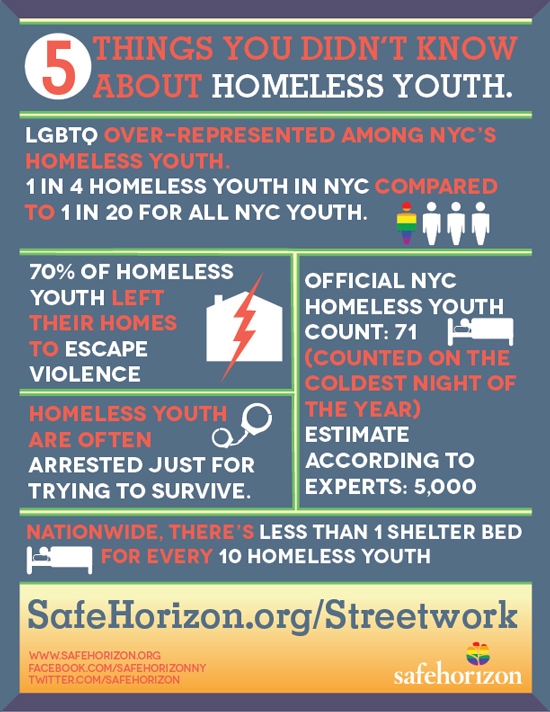Youth represent one of the most vulnerable subpopulations living in homelessness. Many youth living in homelessness are fleeing situations of abuse, discrimination and violence. Service agencies that offer assistance in the form of shelters, counselling, and legal services are of the utmost importance to help these individuals move from crisis to newfound security. The below infographic, published by New York City service agency Safe Horizon, illustrates several eye-opening facts about youth who are homeless.
70% of youth surveyed left their homes to flee violence. This categorization includes fleeing both sexual violence and physical violence. Severe family conflict is a commonly reported reason for youth becoming homeless. Often, it may not be a matter of an individual choosing to leave their homes, but a matter of being forced out of their living situations. For example, homeless LGBTQ2 youth are often forced to leave home because their parents do not accept their gender and/or sexual orientation.
Like in NYC, LGBTQ2 youth are over-represented in Canada’s homeless youth population. While these individuals have to face the difficulties associated with living on the streets, they also have to face the additional stressor of identifying themselves as being LGBTQ2. Toronto is commonly advertised as a safe destination for LGBTQ2, but there are no dedicated shelters for LGBTQ2 youth in the city. Many LGBTQ2 youth go through facing homo/transphobia in the home and school setting and then go on to face discrimination in the shelter system. Many LGBTQ2 youth opt to sleep on the streets rather than in shelters, as they have experienced discrimination and/or violence in shelters. Specialized housing initiatives need to be developed to meet the needs of LGBTQ2 youth. There are currently no specialized housing initiatives that meet the needs of LGBTQ2 youth in Canada (while New York City alone is home to two drop-in shelters for LGBTQ2 youth: the Ali Forney Center and The New Alternatives Centre).
The infographic also illustrates a disturbing growing trend in the United States where homelessness, including youth homelessness, is being criminalized. Homeless people are generally viewed as being threats to public safety. This sweeping generalization directly impacts policy, law, and how the law is enforced. A recent report released by the National Law Center on Homeless & Poverty stated that 18% of cities surveyed had bans in place against sleeping in public, and over 50% of cities surveyed had laws banning sitting or lying down in public. Criminalizing homelessness benefits no one, funding housing solutions is far more affordable and constructive than jailing or fining individuals because of their living situation.
Criminalizing homelessness is no different from turning a blind eye to the actual causes of homelessness and the struggles associated with living on the streets. It’s important that our approach to youth homelessness is informed by research findings and the lived experiences of youth. This is made possible by promoting and participating in an ongoing dialogue between the public and youth. It’s critical that we support services that bridge the care gap that forced these youth into homelessness to begin with. The goals, aspirations and dreams of homeless youth are no less important than those of housed youth. Let’s support these youth, and services tailored to their needs, to help make their hopes for a stable and secure future a reality.


